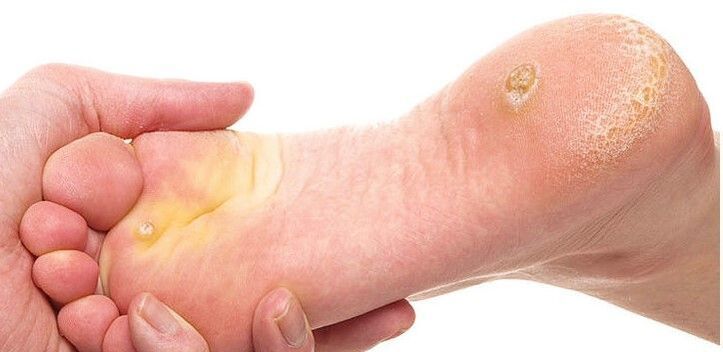
Plantar warts or spines are one of the most unpleasant types of skin growths. Such a formation is located in the holding part of the foot or toes. It consists of overgrown epithelial cells and has a deep root that extends into the depths of the dermis.
Spikes are not a particular hazard to oncogenicity, but can be extremely painful and cause significant discomfort when walking. Such increases are difficult to manage and are characterized by a tendency to decline. How to get rid of plantar warts, which methods are considered the most effective and safest? Read our article on this.
Why do spikes appear?
Warts on the legs are benign tumors of a viral nature. The cause is HPV (papilloma virus) infection. The pathogen spreads from person to person through contact or on the skin when in contact with an infected surface. It feels great in a warm and humid environment where it can be stored for a long time. The risk of infection is particularly high in public places - baths, saunas, gyms, swimming pools. The virus easily enters the body through tiny abrasions or scratches on the skin.
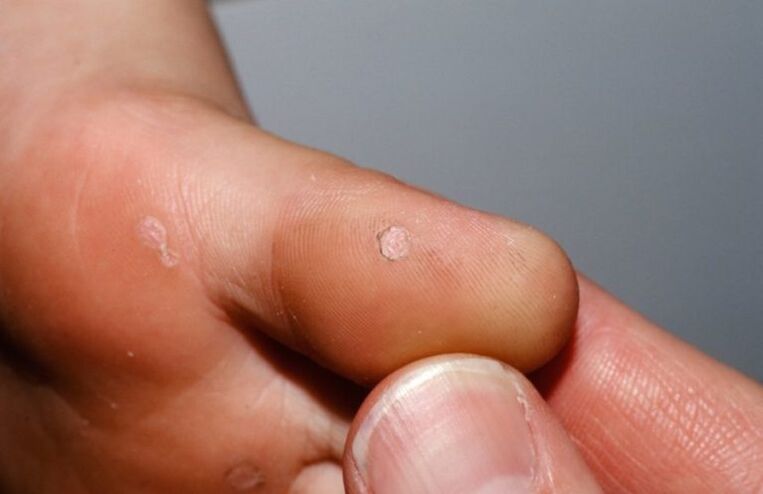
A strong immune system suppresses the growth of the virus and enters a latent state. But as the body’s defenses weaken, the pathogen is activated and begins to multiply rapidly. Recent illnesses, stress, and violations of personal hygiene standards are becoming provocative factors that weaken immune defenses. The following factors contribute to the development of plantar warts:
- excessive sweating of the feet;
- wearing tight, uncomfortable shoes;
- skin microtrauma (abrasions, scratches, wounds, abrasions);
- frequent contact with water and detergents that provoke dry skin;
- chronic diseases with impaired blood circulation in the lower extremities (diabetes mellitus, atherosclerosis, varicose veins);
- foot deformities (flat feet, arthritis of small joints, osteoarthritis);
- constant formation of calli, corns.
You may encounter plantar warts by wearing the shoes of an infected person or by visiting a pedicure salon where the equipment is poorly disinfected. In the child, plantar warts often form after a visit to a pool, summer camp, public shower, where the baby may mistakenly put on someone else’s shoes, walk barefoot on a dirty surface, or use the personal belongings of an infection carrier (towels, dishcloths, etc. ). Parents should teach their baby as soon as possible to adhere to personal hygiene standards and explain why it is impossible to use the things of others.
What does a plantar wart look like?
The incubation period during which the papilloma virus multiplies is quite long - 1, 5-4 months. First, the pathogen affects the basal layer of the epidermis and then spreads upward, leading to characteristic growths on the skin.
Initially, the wart on a child’s or adult’s foot looks like a glossy plaque of round shape and small diameter (up to 2 cm). Soon its surface becomes rough, covered with a dense stratum corneum, rising above the surface of the skin. The color of the spine changes from flesh to yellowish gray. A crater-shaped depression appears in the center of the neoplasm. On closer inspection, black eyes can be seen on the surface of the wart. These are thrombinated capillaries that come to the surface. The presence of this feature makes it possible to distinguish plantar warts from corns or calluses. A photo of the plantar wart gives a complete picture of what this formation looks like on the skin.
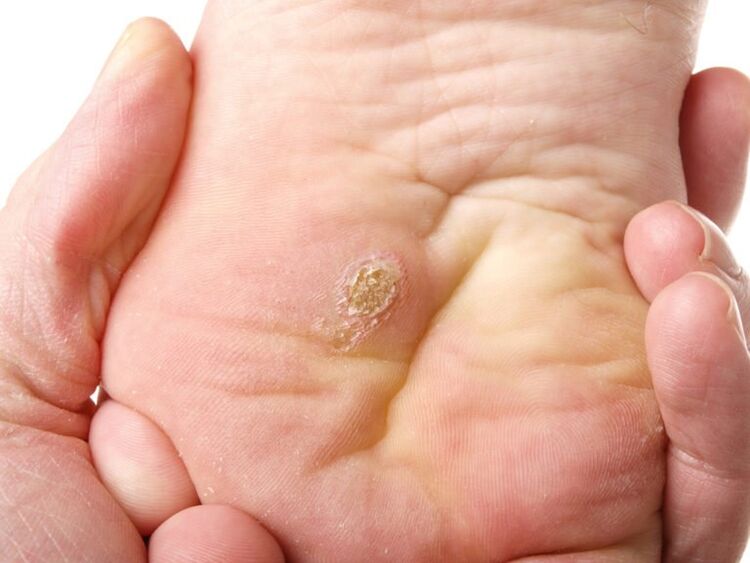
One of the favorite places to locate spikes is the area of the foot that is most exposed to pressure. The root of the neoplasm enters deep into the dermis, irritating nerve endings, so such warts cause painful sensations while walking. The growths on the soles are single and multiple. Usually, a large maternal wart first appears on the leg. If the virus is very active, small daughters will soon form next to it. Sometimes the spine disappears on its own, but more often it leads to an increase in permanent injury and the appearance of severe pain due to the constant pressure of the shoe.
How to get rid of warts on the foot if such formations are painful and cause severe discomfort? First, you should contact a dermatologist for an examination and treatment. Plantar warts are not easy to deal with as they grow deep into the dermis. The root of the neoplasm should be completely removed to prevent the spikes from reappearing. This can be done in different ways - with medication and surgery.
Herbal warts: treatment
There are several methods to treat plantar warts. At home, pharmacy products can be used to treat warts on the feet. The physician must select the therapeutic regimen as a positive effect can only be achieved with the right and competent approach.
Drug therapy
Various methods are used to treat plantar warts at home - from destruction by aggressive chemicals (acids, alkalis) to freezing of abnormal tissues with special devices. To rule out relapses, it is necessary not only to remove the growth but also to suppress the activity of the virus.
The complex treatment is based on the following groups of drugs:
- Antiviral and immunomodulatory agents.The cream, which activates local immunity and inhibits the growth of the virus, has a good therapeutic effect. It should be applied with a bandage twice a day. For the same purpose, a cream is used that stimulates the production of interferon.
- Keratolytic agents.Formulations based on salicylic acid or trichloroacetic acid are designed to soften and exfoliate the rough stratum corneum of the wart. By removing dead scales, you can reach the base of the wart and make it easier for cauterizing or necrotizing solutions to penetrate the root. This is the only way to avoid the re-emergence of new formations and get rid of spikes forever.
- Necrotizing drugs.To combat plantar warts, it is recommended to buy mummifying solutions based on acids or alkalis at the pharmacy. Penetrating into the structure of the neoplasm, aggressive substances burn out the infected tissue, resulting in the wart undergoing necrosis and dying. Precautions should be taken when using such medications, otherwise they may cause chemical burns to healthy skin. Treatment of herbal warts with necrotic agents is allowed only after consultation with a dermatologist.
- Cryopreparations. . . The principle of action of such funds is based on the freezing of wart tissues. At ultra-low temperatures, the fluid inside the abnormal cells freezes and breaks inside. As a result, the wart dies within 7-10 days. The best freezing products are made in aerosol cans with a special applicator.
The procedure should be started after consultation with a dermatologist. Only a professional can properly assess the situation and advise on how to get rid of plantar warts at home. Self-medication often leads to short-term effects and repeated relapses because the spread of the virus cannot be stopped.
Plantar warts in a child
Warts are treated on the child's feet with gentle methods. Children’s skin is fine and thin, so aggressive products can cause irritation or burns. It is best to use drugs with keratolytic effects that soften and exfoliate horny scales. This treatment is not quick - it takes 2-3 weeks to remove the wart.
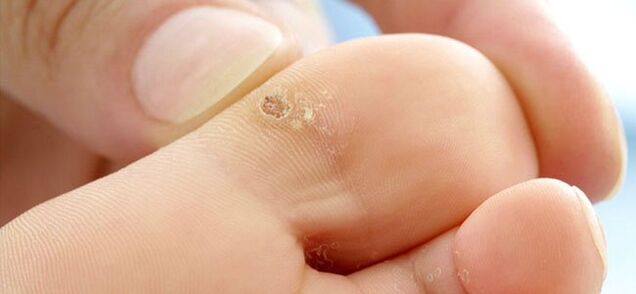
Keratolytics should be initiated in the early stages of neoplasm formation. In this case, recurrence of accumulation can be avoided. If the spine is deeply enlarged, you should resort to hardware treatment methods that provide the desired result and guarantee the absence of relapses.
If the plantar wart does not cause much concern, you can treat it with folk remedies - acetic acid solution, lemon juice, garlic tincture. The acidic environment has a destructive effect on the virus, stopping it from multiplying and preventing it from growing.
Surgery
They rarely resort to the classic operation of a scalpel. Such intervention is only allowed when removing large increments that cannot be eliminated by other methods. The surgery is performed under local anesthesia. The surgeon will excise the wart and thoroughly clean the wound and try to completely remove the deep root. Disadvantages of the method include pain, the risk of wound infection and the development of subsequent complications, a long healing period during which a person has limited mobility.
It is better to remove plantar warts with less traumatic and safe hardware techniques. The procedure is given by the doctor after a preliminary examination and identification of possible contraindications. The main treatment options are:
Electrocoagulation
The essence of the method is to cauterize the accumulated tissue with a high-frequency electric current. The procedure is performed using local anesthesia as it is accompanied by painful sensations. This option is only suitable for removing medium-sized spikes with shallow germination into the depth of the dermis. If large formations have been cauterized, the risk of scar formation and recurrent relapses is not ruled out.

The rehabilitation period after electrocoagulation is quite long, requiring treatment of the wound with antiseptic solutions, except for infection. During the healing process, the patient’s movement is restricted because the load on the foot causes painful feelings.
Cryodestruction
This is one of the most popular and affordable ways to treat plantar warts. The procedure takes only a few minutes and consists of treating the neoplasm with liquid nitrogen. Ultra-low temperatures result in instant freezing. The frozen fluid breaks up the cells of the abnormal neoplasm from the inside - as a result, the wart undergoes necrosis and dies within 10 days.
During the session, the doctor presses the applicator against the neoplasm with the refrigerant for a few seconds, pre-protecting the surrounding healthy tissues. The effectiveness of the procedure is demonstrated by blanching the skin in the treatment area. Soon a blister will form at the site of the wart that should not be touched or pierced. It is recommended to cover with a plaster to avoid injuries. After a few days, the bladder dries out and a crust forms in its place. Once dropped, renewed, healthy skin remains in place of the wart.
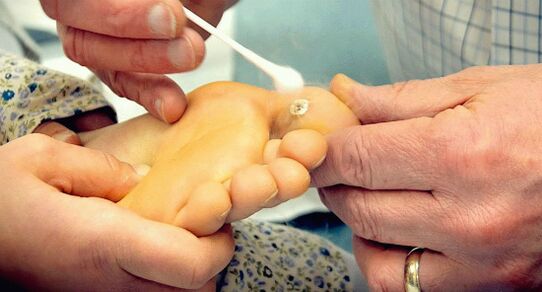
The procedure should only be performed by an experienced professional. Excessive exposure time damages deep tissues and then scars are formed, and excessive superficial exposure does not destroy the wart root, leading to the appearance of new growths.
Laser removal
The modern procedure gives the best aesthetic results, allows to control the depth of exposure, eliminates the risk of complications. The laser radiation evaporates the wart tissue layer by layer, simultaneously coagulating the blood vessels and disinfecting the operating room. Such an effect eliminates the risk of bleeding, infection, guarantees the absence of relapses, as it prevents the spread of virus particles. Different types of lasers are used to remove warts - erbium, acid or pulsed.
The laser procedure is safe, effective and painless and does not require a long healing period. A small wound remains at the site of the removed wart, which is closed by a plaster. After the procedure, the patient can go home immediately and live a normal life. The rehabilitation period is very short - full recovery only takes a few days.
Removal with radio knife
The essence of the latest technology is the use of radio waves, which allows the fastest and safest removal of plantar warts. Strong heat radiation burns the buildup without coming into direct contact with the surrounding tissues. The fluid in the cells of the neoplasm evaporates immediately, causing the wart to die. However, healthy skin is not damaged; during the procedure, the doctor adjusts the depth and duration of the exposure. At the same time, high-frequency radio waves disinfect the surgical space and cauterize the blood vessels, eliminating the risk of bleeding.
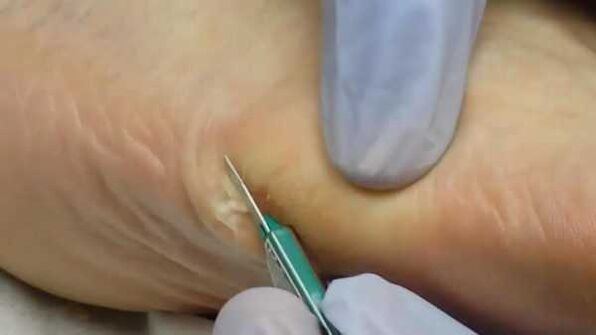
The method of treatment of plantar warts is decided by the patient together with the treating physician. Before prescribing the procedure, the dermatologist will find out the possible contraindications.
List of restrictions on the use of hardware methods:
- inflammatory processes on the skin in the area of treatment;
- diabetes;
- infectious respiratory diseases (ARVI, ARI);
- hypertension;
- exacerbation of herpesvirus infection;
- pregnancy.
The issue of using device-related methods with the child is discussed with the physician. Some procedures are age-restricted, so you should be aware of all the nuances of the proposed methods in advance and make sure that there are no adverse effects on your baby’s health.























